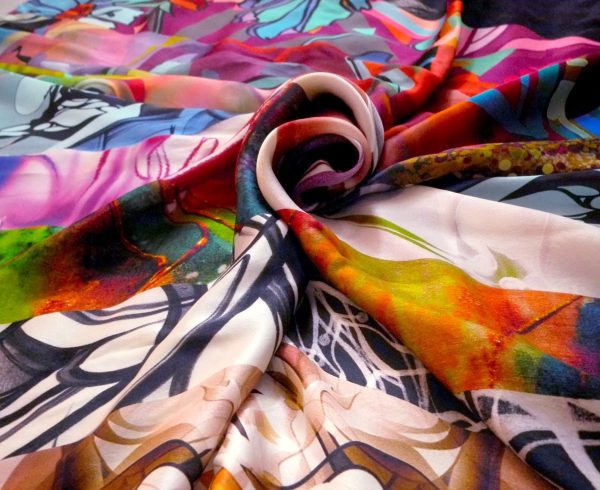Now is the time to be inspired by the Sustainability Vision: In the autumn of 2016, Leadership & Sustainability held a presentation in Seoul on the topic “The Vision of Sustainability in the Textile & Fashion Sector.”
The presentation took place at the Preview exhibition upon an invitation from Kofoti (Korea Federation of Textile Industries) and FITI Testing & Research Institute.
Leadership & Sustainability would like to invite you to watch the presentation. We’d also like to share some insights gained while we were there.
Watch the full presentation here.
The textile and fashion sector is currently facing challenges for sustainability. There are positive signs, however, and we now have a sustainability vision to share. In this article, we cover the following topics for the textile sector:
- Market and Sustainability Trends in the Apparel and Textile Industry
- Sustainability Challenges
- The Sustainability Vision
- Sustainability Focus for Brands, Retailers, and Suppliers
- Collaborative Initiatives
Market and Sustainability Trends in the Apparel and Textile Market
Market Trends
Market Trends can be broken down into three main sectors:
- Manufacturing
- Technology
- Consumer
Within Manufacturing, there is an overall cost increase, especially in some sourcing countries, such as China. The cost increases are partly due to increased labour costs, but also due to energy costs and other expenses.
Companies are taking financial costs into consideration, but must also consider issues like labour policy, transportation, energy, leadership talent, capital regulation, and trade policy. The increasing demand for transparency when it comes to manufacturing will also influence sustainability. A significant degree of many brands’ efforts today focus on the supply chain [1]. Manufacturing and Technology are similar topics in the textile sector. So, now we will cover the technological aspects of the industry.
Related to Technology, there are numerous changes in manufacturing processes, with more automation being a general trend; this is not surprising for those in manufacturing. Examples include 3D printing technology and smart textiles. There are fabrics available that help regulate body temperature, reduce wind resistance, and control muscle vibration – all of which contribute to improving athletic performance.
Consumer trends are increasing demand for speed and customized products too. Moreover, we are all experiencing the increasing power of social media, and social media plays a critical role in the textile sector as well.
Now that we have covered market trends let’s have a look at sustainability trends before we move to the challenges in textile manufacturing. Later, we will discuss the sustainability vision.
What about Sustainability Trends?
PEF Product Environmental Footprint
In general, we can see a high level of activity among brands, retailers, suppliers, collaborative initiatives, NGOs, as well as regulatory agencies related to sustainability programs.
The PEF – Product Environmental Footprinting – and the EU Commission initiative in collaboration with SAC (Sustainable Apparel Coalition) is the Single Market for Green Products. The methods proposed are tested with more than 280 volunteering companies and organisations. The process includes developing a product, sector-specific rules, different approaches for verification, and communication methods for notifying consumers and stakeholders on LCA performance.
Pilot studies are underway for footwear and apparel products in collaboration with these manufacturing companies. Some of these enterprises are, for footwear, Adidas, Stella McCartney, Nike, Timberland, and W.L. Gore & Associates.
Chemicals Management
Chemicals management is one of the toughest sustainability areas to tackle in the textile supply chain. Historically, brands and retailers have relied on RSL (Restricted Substances Lists), materials, and product testing.
However, this approach does not ensure that harmful chemicals stay out of the manufacturing processes. Now, companies are beginning to understand that they need to have a proactive approach to chemicals input management. For the sector, this needs pivotal thinking and a clear sustainability vision. More so, the textile industry must move away from the “sole” focus on product safety and head toward a more holistic approach to chemicals management. A lot of pressure has been exercised in this regard during the past five years by NGOs such as Greenpeace.
Circular Economy
While it’s certainly a business buzzword, in essence circular economy refers to a new focus on recycling or upcycling (i.e., the ambition is to close the loop). Finally, consumers are demanding more sustainable products, but they also demand the lowest price for the sustainable products they buy. The fast/cheap fashion trend has certainly cast its spell on consumers and given them a false impression about pricing.
Microfibers
Most recently, the topic of pollution of the sea by microfibers has received increased attention. Pollution is a significant challenge to brands and suppliers since the use of synthetic fibres is so widespread, and there is no apparent solution to the pollution problem as of yet.
Sustainability Challenges and Levers
We’ve covered the trends; now let‘s look at the main sustainability challenges and how to handle them:
Lack of Standards
One of the main challenges we see is that there is no standard available for how to understand and address sustainability in the textile sector.
The limited rules leave the door open for interpretations and create a lack of guidance on how to evaluate sustainability programs managed by brands, retailers, and suppliers. More so, assessing the effectiveness of these programs is difficult.
We often see plenty of flashy stories, but less often do we hear about which impact the programs behind them make and if they are addressing the more material (significant) topics. Our firm view is that anyone wishing to be effective when it comes to sustainability needs to analyse the impacts, risks, and opportunities (to make a materiality assessment along the value chain and then build a strategy based on those findings).
Supply Chain Opacity
Another significant challenge in the supply chain is that it’s often not transparent and known, especially upstream from T1.
So, brands and retailers must invest in mapping their supply chain and working with their suppliers to do so.
We are aware of one other challenge: the cost pressure and volatility in sourcing. The cost pressure and volatility occurs due to the reduction in clothing prices compared to 30 or 40 years ago. Cheap pricing allows for people to buy a lot of clothes, and demanding even lower prices for future purchases. Competitors outcompete each other with cheap clothing, and so we have an enormous cost pressure.
Overcoming cost pressure is certainly a tricky challenge. To do so, we must look for solutions at a policy level. Also, we must demand the best sustainability practices within those policies.
We need brands and retailers to reflect on their purchasing practices, and we need consumers to think about their consumption patterns. By doing so, we lead ourselves into the Sustainability Vision.
While opacity is a tough topic to tackle for most brands, we will look at it from the supplier’s perspective for further insight.
At the supplier level, we see the problem of multiple audits by brands and retailers, often per different standards. It is difficult for suppliers to conform to different requirements, and the resources they need to invest in managing all the audits they undergo are significant.
However, to be fair, if all suppliers had good sustainability standards in their operations, then the need to control would not be that significant. So, we see that vendors need to step up and take responsibility for their operating standards and show that they can operate in a self-governance model. We also need brands to align with one standard for conformity.
Chemicals Management
Chemicals management is another significant challenge. As we mentioned before, the reason is that textile chemistry is incredibly complex, and chemical reactions take place in most manufacturing stages (sometimes even after production). Chromium VI is just one example.
Many brands have built their RSL work or otherwise relied on external support to manage chemicals. Now they are challenged to design and implement approaches for an integrated chemicals management and to manage the input of chemicals into the processes.
One lever here is obvious: training and communication.
Again, it is important to align behind approaches, so it is helpful to see the collaborative initiatives like ZDHC (Zero Discharge of Hazardous Chemicals). Furthermore, in our view, it will be important that brands and retailers take a holistic approach and embed chemicals management into their overall environmental, health, and safety programs. Again, they must ensure that they take care of impacts, risks, and opportunities.
Lastly, let‘s not forget: a good program will also save money and resources.
The Detox Campaign was launched by Greenpeace in July 2011 and triggered by chemicals in wastewater discharges in Asia in the Dirty Laundry Report.
The focus is simple: the textile industry and the urgency to take responsibility and eliminate the use of hazardous chemicals – including the 11 priority groups identified by Greenpeace.
Upon the launch of the Dirty Laundry Report, Greenpeace contacted several international fashion brands and challenged them, one by one, to sign the Detox Commitment.
Within five years, around 20 fashion brands have publicly committed to Detox, per the standard developed by Greenpeace:
- The companies should commit to phasing out the use and release of all toxic chemicals from their global supply chains by 2020.
In the latest Detox Catwalk published in July 2016, evaluations include three categories: Avant-Garde, Evolution Mode, and Faux Pas.
Greenpeace started with very challenging requirements already, like disclosure of wastewater discharges, elimination of several groups of chemicals, and the call for a phase out of PFCs (Perfluorinated Chemicals). However, over time they have added more requirements. The new requirements go above and beyond chemicals management, and focus on closed-loop operations and responsible business models.
Now, let‘s turn from the challenges we’ve discussed to the solutions and how they play a role in the sustainability vision.
The Sustainability Vision
The vision is very simple, and it’s obvious we must focus on best practices in the textile sector:
Design, produce and market apparel, footwear, equipment and textile products with the highest level of responsibility and care for the environment and the health, safety, and well-being of the people purchasing the products.
Sustainability Focus for Brands, Retailers, and Manufacturers – The Strategy
There is no recipe in a one-size-fits-all approach to sustainability greatness, but here are a few guidelines to follow:
- Focus on what’s material regarding impacts, risks, and opportunities for sustainability.
- Align and harmonise, then share results.
- Understand how to improve standards in the manufacturing and textiles sector.
- Follow the value chain and manufacturing process flow.
- Develop a solid strategy.
- Embed sustainability into business processes daily.
- Create results first, then speak about them and share with the public.
With the basics in mind, let‘s move deeper into the Sustainability Vision and look at the actual things companies can do.
Materiality
- Assess your business for materiality (i.e. where are the sustainability impacts, risks, and opportunities?)
- Look at all your business processes and evaluate
- To have a good structure, we usually work along the value chain.
Now you can assess all the sustainability aspects that you identified. Evaluate them for status (i.e. what’s in place or what is not in place), impact, legal, financial, operational risks, and opportunities.
There are many ways you can do the assessment.
For example, you can do it at a higher-level in a brainstorming or workshop session. You can also develop a questionnaire and conduct interviews with the principal stakeholders. You may wish to include footprinting with quantitative measures or even product life cycle assessments.
The results can be inserted into a matrix and then valued on a scale that you have pre-defined. The goal should be to understand your material sustainability aspects, as well as your gaps. Once you have understood the materiality of your business, then you can develop your strategy.
Developing Your Strategy
Based on the assessment and focusing on the material aspects, you create your own sustainability vision and plan. A strategy should be unique to your company and be a perfect fit with your enterprise’s overall operating strategy.
Ecotextile News features a business case for implementing a strategy that we highly recommend reviewing [2].
First, you start by defining a few tentative goals. Then, you check that the goals align with each other. Third, you draft programs that would help reach those interim goals. Fourth, you examine impacts and costs as well as the business case. Lastly, you test the strategy as a whole. You assess the data as well as the entire business case, then adjust as you see fit. You may work through this cycle several times until you perfect the strategy the strategy.
Supply Chain
Now we want to give just one area as an example where brands and retailers can engage: the supply chain.
Most brands in the textile sector have significant impacts and risks in the supply chain. Brands and retailers need to create strong partnerships with their suppliers, where there is a win-win commitment. Management of social and environmental aspects per the impacts and materiality is a necessity. Also, brands and retailers need to continue to move beyond T1, and head toward T2 and T3.
To do so, they need to know who their suppliers are, so mapping is a valuable tool. Here it‘s also possible to build a traceability system, hopefully with an aligned approach for all materials and products – without different standards for every material.
Some Advice for Suppliers
The most important step is to take ownership over sustainability practices in your manufacturing. You must develop your capabilities within the sustainability vision and plan. You can do so by working with SAC’s Higg Index and with your customers.
Luckily, our team can support you in improving your sustainability performance. Get in touch with us to learn more.
Collaborative Initiatives
The Higg Index
Sustainable Apparel Coalition was founded in 2009 with the mission to develop a universal approach to measuring sustainability performance in the textile sector.
The vision is an apparel, footwear, and home textiles industry that produces no unnecessary environmental harm and has a positive impact on the people and communities associated with its activities.
The tool, the Higg Index, is a suite of assessment tools that empower brands, retailers, and manufacturers to measure their environmental, social, and labour impacts. Today, SAC has 175+ members and covers around 40 percent of the entire textile sector.
In 2011, the Higg Index was introduced. Today there have been 13,000 Higg assessments conducted. The Higg Index offers companies the ability to assess at every stage of the lifecycle and value chain, and it accommodates enterprises of all capacities. The tool also covers different areas, such as:
- Brand: Environment, Apparel/Textiles, Footwear and Social/Labour
- Facility: Environment and Social/Labour
- Product: Design and Development Module and PEF
- Materials: MSI, Materials Sustainability Index
SAC members can share their results with each other too for communal learning opportunities.
What is the future of the Higg Index? Well, ultimately SAC and its members wish to have a scalable tool that is verified, and that can be communicated to consumers and the public.
Currently (Q1 2017) the Facility Environmental Module FEM 3.0 is in “pressure testing,” and Leadership & Sustainability can assist you with the verification.
Leadership & Sustainability is a member of SAC and a SAC trainer. By being a member, we wish to support the industry’s sustainability vision.
Receive Help with Implementing Your Sustainability Vision Today
For those of you who are interested in learning about how brands succeed when it comes to the management of environmental aspects of the supply chain, we recommend the IPE / NRDC research. This set of research has evaluated nearly 200 international brands in several industries. Within that evaluation, the IPE/NRDC creates a ranking system [3].
The bottom line? The challenges in the fashion and textile sector are intense. However, with a great degree of collaboration, and a harmonisation of standards that includes the full supply chain, there is light on the horizon.
Our team has defined the Sustainability Vision that will take us into the future and show us the way to proper sustainability.
Get in touch with Leadership & Sustainability through our online booking system to see how our service empowers those in the textile and manufacturing sector.
Download the full presentation.
Read more about The Higg Index.
Read more about our solutions.
Read more about Karin.
Contact us – your inquiry.
If you wish to receive regular news updates from us, please subscribe to our Newsletter.
Resources and further readings:
- McKinsey & Company, 2012. “Manufacturing the future: The next era of global growth and innovation”. Retrieved from: http://www.mckinsey.com/business-functions/operations/our-insights/the-future-of-manufacturing
- Ekberg, 2016. “Making the corporate case for sustainability” from Ecotextile News December 2016 / January 2017, p. 54-55.
- Institute of Public and Environmental Affairs (IPE)/ Natural Resources Defense Council (NRDC), 2016. “Greening the Global Supply Chain. CITI Index 2016 Annual Evaluation Report”. Retrieved from: http://wwwoa.ipe.org.cn//Upload/201610280455082261.pdf
- Advanced and Sustainable Textiles, 2016. Retrieved from: http://advancedtextilessource.com/2016/07/sustainable-advanced-textiles/
- adidas Press Release, July 2016: http://www.adidas-group.com/en/media/news-archive/press-releases/2016/adidas-group-provides-further-details-its-three-strategic-choice/
- adidas Press Release, October 2016: http://www.adidas-group.com/en/media/news-archive/press-releases/2015/adidas-breaks-mould-3d-printed-performance-footwear/
- Berg and Hedrich, 2014. “What’s next in apparel sourcing?” McKinsey & Company”
- EU Commission documents, 2016. “The Slovak Presidency of the Council of the European Union in the Context of Current Events”. Retrieved from: http://www.eu2016.sk/data/documents/the-slovak-presidency-of-the-council-of-the-european-union-in-the-context-of-current-events.pdf
- Fashion Revolution, Who Made My Clothes. Retrieved from: http://fashionrevolution.org/about/transparency/
- Forbes, 2014.”What is the Future of Fabrics? These Smart Textiles will blow your mind”, Retrieve from: http://www.forbes.com/sites/forbesstylefile/2014/05/07/what-is-the-future-of-fabric-these-smart-textiles-will-blow-your-mind/#712907254914
- Harvard Business Review, 2010. “The Transparent Supply Chain”, Retrieved from: https://hbr.org/2010/10/the-transparent-supply-chain
- International Apparel Federation, 2015. “Some lessons learned from WFSGI Manufacturers Forum “Beyond Lean Manufacturing”, Retrieved from: http://iafnet.eu/iaf-news/some-lessons-learned-from-wfsgi-manufacturers-forum-beyond-lean-manufacturing/
- Just-Style, Jan 2016.”Outlook 2016- Apparel industry challenges and opportunities”. Retrieved from: http://www.just-style.com/management-briefing/outlook-2016-apparel-industry-challenges-and-opportunities_id126918.aspx
- Keller, Magnus, Hedrich, Nava & Tochtermann, 2014. “Succeeding in tomorrow’s global fashion market”. McKinsey & Company. Retrieved from: http://www.mckinseyonmarketingandsales.com/sites/default/files/pdf/CSI_Apparel2020-NEWBRAND.pdf
- Lu, Remy, Schmidt, & Werner, 2014. “Fashion sense: Leading apparel companies are looking to cities for growth”. McKinsey & Company. Retrieved from: http://www.mckinseyonmarketingandsales.com/sites/default/files/pdf/Fashion-article-PDF-042213.pdf
- Nike Press Release, May 2016: http://news.nike.com/news/nike-hp-3d-printing
- Single Market For Green Products, Retrieved from: http://ec.europa.eu/environment/eussd/smgp/index.htm
- Tarmy, J., 2016”The Future of Fashion is 3D Printing Clothes at Home”. Bloomberg. Retrieved from: http://www.bloomberg.com/news/articles/2016-04-15/3d-printing-is-poised-to-bring-haute-couture-into-the-home









Leave a Comment